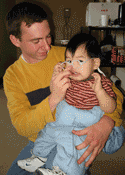Alaska Blind Child Discovery
Consistent Optical Therapy for Amblyopia
Home
I
trained in ophthalmology at the Mayo Clinic in Rochester Minnesota. Rochester
Optical is even farther away than that. As such, they can provide optional
optical devices for Alaska citizens who might benefit from them for academic
reasons. But I have serious concerns regarding their ability to provide
of Alaskans who are under therapy for amblyopia.
Recall that amblyopia is deficient
(and potentially permanent) learning of brain vision. An extremely important
component of amblyopia therapy is providing clear images that are binocularly
aligned. Two thirds of amblyopic patients have a substantial refractive
component, either anisometropia, high hyperopia, high astigmatism, or
occasionally severe myopic (staphyloma) or hyperopic (aphakic) anisometropia.
Refractive correction is often combined with patching or penalization
therapy for the remediation of amblyopia. But there are many cases of
amblyopia, if detected early enough, that can be successfully treated
with early, and consistent refractive correction alone.
Imagine the follow scenario: a young diabetic child is sent to his home
village with one fragile glass vial of insulin. Within a week, you get
a report that the insulin vial just broke. Following your honorable cost-containment
guidelines, you order insulin from Rochester New York to be efficiently
and promptly delivered to the patient. By the mail. Surface.
The same thing happens with Medicaid and Denali KidCare refractive correction
for amblyopia: spectacles take about 4-8 weeks to arrive, and when they
break, kids go without the medically necessary benefit of optical clarity
and accommodative relaxation for an additional 2 months. During this time,
their initial mild-moderate refractive amblyopia (368.03, 369.76) morphs
to a severe mixed form of amblyopia (368.01, 368.03, 369.72). Recovery
from the more severe form of amblyopia takes much more intense therapy
including compliant patching.
It is often difficult to achieve compliant patching in rural or urban
Alaska.
For two important reasons, I recommend a modification in the way optical
correction is dispensed to children with amblyopia, and I offer a cost-effective
paradigm:
1. Alaskan eye doctors who specialize in delivering Gold Standard Confirmatory
Exams and delivering state-of-the art amblyopia therapy should have the
freedom to prescribe rapid, sturdy optical amblyopia rehabilitative aids
(spectacles or contact lenses).
2. The diagnoses for which these aids can be prescribed would be: refractive
amblyopia (368.03), strabismic amblyopia (368.01), deprivational amblyopia
(368.02), severe myopia (360.21) and aphakia (379.31).
3. Optical rehabilitation aids should apply only to Medicaid recipients
aged 0 to 11 years.
4. Medicaid recipients will have at least one back-up pair or set of optical
aids. This means the initial prescription should be filled with two sets.
5. At least one of the initial spectacles should have sturdy, widely-fitting
frames (i.e Bambino™ flexible nylon frames).
6. Broken or lost optical rehabilitative aids should be rapidly replaced.
7. The eye doctor who prescribes the optical rehabilitative aids should
not be financially rewarded by the dispensing optical business.
The most important reason to adopt this policy is to alleviate
the future disability of residual amblyopia in Alaskans. It is the right
thing to do. Robert
W. Arnold MD
ABCD History
Kids Eye Disorders
Amblyopia
Vision Screening

